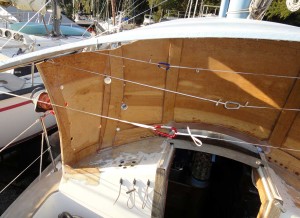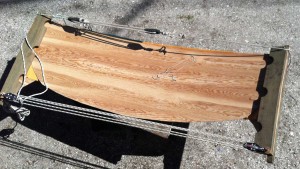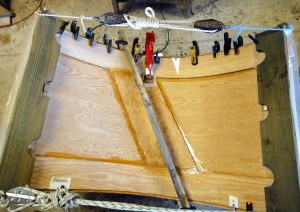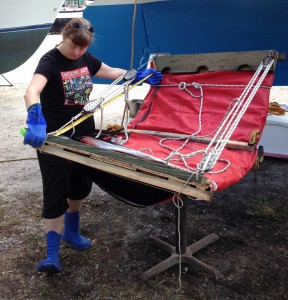“OK, I admit it,” said Barry, one morning. “I’m loving the hell out of this.”

I was so shocked by his statement, I would have fallen out of bed had that been possible. Fortunately, it’s not possible to fall out of the v-berth aboard Flutterby.
We were discussing his progress on our winter project, building a hard dodger and arch on which to mount our solar panels. Unlike most boat projects, it was not taking twice as long as he expected. It was taking Barry ten times as long as he expected, and when he made the statement in the v-berth, in early March, I saw no end in sight.
I was not enjoying the hell out of it. Five months of freezing my butt off, in a boat on land, with no car, six miles from the dying town of St. Marys, Georgia, had a completely different effect on me. I had slowly sunk into the depths of despair.
I asked Barry to explain to me what it was that he was loving so much, when all I saw was head-scratching, frustration, and outright failure. “Learning curves,” he said.
I laughed at his unintentional double entendre. The reason the dodger has taken ten times longer than expected is because instead of building a simple, squared-off shape out of marine plywood, we decided we wanted it curved, to match the shape of Flutterby. Most builders would have used fiberglass, which is what the boat is made of. Barry prefers working with wood, though. He opted to build it out of what he calls “tortured plywood.”

Becoming increasingly more animated, he explained how the process of learning how to bend and laminate plywood into complex three-dimensional shapes, how to fit them onto the deck of a boat, how to get maximum strength with the lightest materials, was forcing him to use his brain to learn amazing new things.
While I thought he was sitting at his computer, reading LOLCats and surfing Facebook, he was actually using his time to do high-level research and calculations.
“I was spending way too long doing trigonometry and numerical solutions to figure out bending curves and camber and calculating how much the plywood’s going to spring back after you torture it,” he explained. He went on to tell me what he really meant when he said “learning curves.”
“There’s this initial part of a learning curve where you really suck at it. It’s not very fun,” he told me. “It’s slow as hell, because I’m still learning this shit and I’m cracking plywood when I try to bend it…”

I remember the saddest day, in December. He’d spent weeks designing the sides and figuring out how to build them, and together, we spent a day laminating them together. When the epoxy kicked and he took his jig apart, he was almost in tears. We’d made two port sides and zero starboard sides. When he realized that neither of the port sides fit, I think he really was in tears.
Weeks later, we tried again. That time, the plywood cracked and the two sides ended up asymmetrical. He decided to use them anyway.
It was after he attached the asymmetrical sides to the front that he went bananas with trigonometry, trying to figure out how to build a curved top that looked symmetrical. Perfection was impossible, and he studied it for weeks, trying to figure out a compromise solution. He turned to websites about how to bend wood for ukeleles and guitars for answers.
“I have new respect for people who build musical instruments. If I played them, I could digress and waste years on this.” He admitted that his screen time had not all been productive; he’d spend some of it reading and dreaming about the wonderful woodworking tools he would like to have. He shook his head, saying, “I don’t need to have all those toys now. I just need to get this dodger done.”
“I’ve spent more time on this learning curve than I’ve spent fretting on the fact that the dodger is not quite perfect. I don’t know any way I could have gone about this without learning this stuff … but when I started it, I didn’t realize how much I had to learn.”

